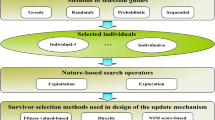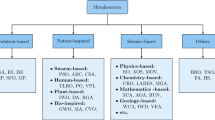Abstract
Optimization techniques play a crucial role in improving the performance of machine learning applications. However, traditional techniques may not be suitable for addressing complex problems that involve numerous parameters requiring adaptation. This paper presents a novel variant of the gradient-based optimizer (GBO) and investigates the effectiveness of integrating the harmony search (HS) algorithm to enhance the GBO algorithm. The HS algorithm offers several advantages, including fast convergence and fewer adjustable parameters. The proposed method, called GBOHS, is evaluated through three experiments. The first experiment focuses on solving global optimization problems, while the second experiment assesses its ability to select the most relevant features using sixteen benchmark feature selection datasets. The final experiment applies the GBOHS method to solve five real engineering problems. The results are compared against those of well-known optimization algorithms using various performance measures, including fitness function value and classification accuracy. The findings demonstrate that the proposed GBOHS method achieves high accuracy and consistently outperforms the compared methods across all the experiments, demonstrating its promising effectiveness.










Similar content being viewed by others

References
Zhang J, Cheng X, Zhao M, Li J (2023) ISSWOA: hybrid algorithm for function optimization and engineering problems. J Supercomput 79(8):8789–8842
Aydemir SB (2024) Ideal solution candidate search for starling murmuration optimizer and its applications on global optimization and engineering problems. J Supercomput 80(3):4083–4156
Yuan Q, Wang S, Hu M, Zeng L (2024) SLDChOA: a comprehensive and competitive multi-strategy-enhanced chimp algorithm for global optimization and engineering design. J Supercomput 80(3):3589–3643
Shen Y, Zhang C, Gharehchopogh FS, Mirjalili S (2023) An improved whale optimization algorithm based on multi-population evolution for global optimization and engineering design problems. Expert Syst Appl 215:119269
Tubishat M, Ja’afar S, Alswaitti M, Mirjalili S, Idris N, Ismail MA, Omar MS (2021) Dynamic salp swarm algorithm for feature selection. Expert Syst Appl 164:113873
Gaheen MM, ElEraky RM, Ewees AA (2021) Automated students Arabic essay scoring using trained neural network by e-jaya optimization to support personalized system of instruction. Educ Inf Technol 26(1):1165–1181
Sidhom O, Ghazouani H, Barhoumi W (2023) Three-phases hybrid feature selection for facial expression recognition. J Supercomput 80:1–35
Rajalakshmi R, Sivakumar P, Krishna Kumari L, Chengathir Selvi M (2024) A novel deep learning model for diabetes mellitus prediction in iot-based healthcare environment with effective feature selection mechanism. J Supercomput 80(1):271–291
Barhoush M, Abed-alguni BH, Al-qudah NEA (2023) Improved discrete salp swarm algorithm using exploration and exploitation techniques for feature selection in intrusion detection systems. J Supercomput 79:1–45
Ahmadianfar I, Bozorg-Haddad O, Chu X (2020) Gradient-based optimizer: a new metaheuristic optimization algorithm. Inf Sci 540:131–159
Ahmadianfar I, Gong W, Heidari AA, Golilarz NA, Samadi-Koucheksaraee A, Chen H (2021) Gradient-based optimization with ranking mechanisms for parameter identification of photovoltaic systems. Energy Rep 7:3979–3997
Khalilpourazari S, Doulabi HH, Çiftçioğlu AÖ, Weber G-W (2021) Gradient-based grey wolf optimizer with gaussian walk: Application in modelling and prediction of the covid-19 pandemic. Expert Syst Appl 177:114920
Jiang Y, Luo Q, Zhou Y (2022) Improved gradient-based optimizer for parameters extraction of photovoltaic models. IET Renew Power Gener 16(8):1602–1622
Raval S, Natarajan T, Deb S (2023) A novel levy-enhanced opposition-based gradient-based optimizer (LE-OB-GBO) for charging station placement. Electronics 12(7):1522
Maleki A, Nazari MA, Pourfayaz F (2020) Harmony search optimization for optimum sizing of hybrid solar schemes based on battery storage unit. Energy Rep 6:102–111
Talaei K, Rahati A, Idoumghar L (2020) A novel harmony search algorithm and its application to data clustering. Appl Soft Comput 92:106273
Hasanipanah M, Keshtegar B, Thai D-K, Troung N-T (2020) An ANN-adaptive dynamical harmony search algorithm to approximate the flyrock resulting from blasting. Eng Comput 38:1–13
Ahmed S, Ghosh KK, Singh PK, Geem ZW, Sarkar R (2020) Hybrid of harmony search algorithm and ring theory-based evolutionary algorithm for feature selection. IEEE Access 8:102629–102645
Singh N, Kaur J (2021) Hybridizing sine-cosine algorithm with harmony search strategy for optimization design problems. Soft Comput 25(16):11053–11075
Geem ZW, Kim JH, Loganathan GV (2001) A new heuristic optimization algorithm: harmony search. Simulation 76(2):60–68
Peraza C, Valdez F, Castillo O (2015) A harmony search algorithm comparison with genetic algorithms. In: Theory and applications, fuzzy logic augmentation of nature-inspired optimization metaheuristics, pp 105–123
Yusup N, Zain AM, Latib AA (2019) A review of harmony search algorithm-based feature selection method for classification. J Phys Conf Ser 1192:012038
Guha S, Das A, Singh PK, Ahmadian A, Senu N, Sarkar R (2020) Hybrid feature selection method based on harmony search and naked mole-rat algorithms for spoken language identification from audio signals. IEEE Access 8:182868–182887
Alshammari N, Asumadu J (2020) Optimum unit sizing of hybrid renewable energy system utilizing harmony search, jaya and particle swarm optimization algorithms. Sustain Cities Soc 60:102255
Kennedy J, Eberhart R (1995) Particle swarm optimization. In: Proceedings of ICNN’95-International Conference on Neural Networks, vol 4, pp 1942–1948. IEEE
Mirjalili S (2016) Dragonfly algorithm: a new meta-heuristic optimization technique for solving single-objective, discrete, and multi-objective problems. Neural Comput Appl 27(4):1053–1073
Mitchell M (1998) An introduction to genetic algorithms. MIT press
Mirjalili S (2015) Moth-flame optimization algorithm: a novel nature-inspired heuristic paradigm. Knowl-based Syst 89:228–249
Price KV, Awad NH, Ali MZ, Suganthan PN (2018) Problem definitions and evaluation criteria for the 100-digit challenge special session and competition on single objective numerical optimization. In: Technical Report. Nanyang Technological University Singapore
Tanabe R, Fukunaga AS (2014) Improving the search performance of shade using linear population size reduction. In: 2014 IEEE Congress on Evolutionary Computation (CEC), pp 1658–1665. IEEE
Mohamed AW, Hadi AA, Fattouh AM, Jambi KM (2017) Lshade with semi-parameter adaptation hybrid with CMA-ES for solving CEC 2017 benchmark problems. In: 2017 IEEE Congress on Evolutionary Computation (CEC), pp 145–152. IEEE
Wang Y, Li H-X, Huang T, Li L (2014) Differential evolution based on covariance matrix learning and bimodal distribution parameter setting. Appl Soft Comput 18:232–247
Ibrahim RA, Ewees AA, Oliva D, Elaziz MA, Lu S (2019) Improved salp swarm algorithm based on particle swarm optimization for feature selection. J Ambient Intell Humaniz Comput 10(8):3155–3169
Nottingham K, Kelly M, Longjohn R (2023) UCI machine learning repository. Available at http://archive.ics.uci.edu/ml
Faris H, Mafarja MM, Heidari AA, Aljarah I, AlÃM A-Z, Mirjalili S, Fujita H (2018) An efficient binary salp swarm algorithm with crossover scheme for feature selection problems. Knowl-Based Syst 154:43–67
Minocha S, Singh B (2022) A novel phishing detection system using binary modified equilibrium optimizer for feature selection. Comput Electr Eng 98:107689
Ibrahim RA, Abualigah L, Ewees AA, Al-Qaness MAA, Yousri D, Alshathri S, Elaziz MA (2021) An electric fish-based arithmetic optimization algorithm for feature selection. Entropy 23(9):1189
Ewees AA, Abualigah L, Yousri D, Algamal ZY, Al-Qaness MAA, Ibrahim RA, Elaziz MA (2022) Improved slime mould algorithm based on firefly algorithm for feature selection: a case study on QSAR model. Eng Comput 38(3):2407–2421
Mafarja MM, Mirjalili S (2017) Hybrid whale optimization algorithm with simulated annealing for feature selection. Neurocomputing 260:302–312
Ewees AA, Ismail FH, Sahlol AT (2023) Gradient-based optimizer improved by slime mould algorithm for global optimization and feature selection for diverse computation problems. Expert Syst Appl 213:118872
Mirjalili S, Mirjalili SM, Hatamlou A (2016) Multi-verse optimizer: a nature-inspired algorithm for global optimization. Neural Comput Appl 27(2):495–513
Mirjalili S, Lewis A (2016) The whale optimization algorithm. Adv Eng softw 95:51–67
Mirjalili S, Mirjalili SM, Lewis A (2014) Grey wolf optimizer. Adv Eng Softw 69:46–61
Heidari AA, Mirjalili S, Faris H, Aljarah I, Mafarja M, Chen H (2019) Harris hawks optimization: algorithm and applications. Future Gener Comput Syst 97:849–872
Savsani P, Savsani V (2016) Passing vehicle search (PVS): a novel metaheuristic algorithm. Appl Math Model 40(5–6):3951–3978
Venkata Rao R, Savsani VJ, Vakharia DP (2011) Teaching-learning-based optimization: a novel method for constrained mechanical design optimization problems. Comput-Aided Design 43(3):303–315
Saremi S, Mirjalili S, Lewis A (2017) Grasshopper optimisation algorithm: theory and application. Adv Eng Softw 105:30–47
Gandomi AH, Yang X-S, Alavi AH (2013) Cuckoo search algorithm: a metaheuristic approach to solve structural optimization problems. Eng Comput 29(1):17–35
Acknowledgements
The authors are thankful to the Deanship of Graduate Studies and Scientific Research at University of Bisha for supporting this work through the Fast-Track Research Support Program.
Funding
The author declares that no funds, grants, or other support were received during the preparation of this manuscript.
Author information
Authors and Affiliations
Contributions
A. Ewees was involved in conceptualization, methodology, investigation, data curation, writing—original draft, and writing—reviewing and editing.
Corresponding author
Ethics declarations
Conflict of interest
The author declares no Conflict of interest.
Additional information
Publisher's Note
Springer Nature remains neutral with regard to jurisdictional claims in published maps and institutional affiliations.
Rights and permissions
Springer Nature or its licensor (e.g. a society or other partner) holds exclusive rights to this article under a publishing agreement with the author(s) or other rightsholder(s); author self-archiving of the accepted manuscript version of this article is solely governed by the terms of such publishing agreement and applicable law.
About this article
Cite this article
Ewees, A.A. Harmony-driven technique for solving optimization and engineering problems. J Supercomput 80, 17980–18008 (2024). https://doi.org/10.1007/s11227-024-06100-1
Accepted:
Published:
Issue Date:
DOI: https://doi.org/10.1007/s11227-024-06100-1



